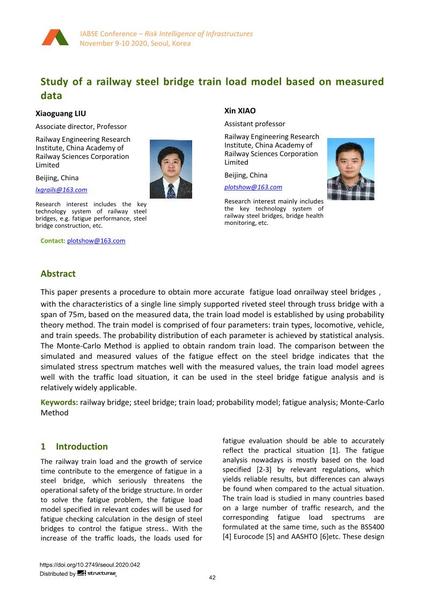Study of a railway steel bridge train load model based on measured data

|
|
|||||||||||
Bibliographic Details
| Author(s): |
Xiaoguang Liu
(Associate director, Professor, Railway Engineering Research Institute, China Academy of Railway Sciences Corporation Limited, Beijing, China)
Xin Xiao (Assistant professor, Railway Engineering Research Institute, China Academy of Railway Sciences Corporation Limited, Beijing, China) |
||||
|---|---|---|---|---|---|
| Medium: | conference paper | ||||
| Language(s): | English | ||||
| Conference: | IABSE Conference: Risk Intelligence of Infrastructures, Seoul, South Korea, 9-10 November 2020 | ||||
| Published in: | IABSE Conference Seoul 2020 | ||||
|
|||||
| Page(s): | 42-50 | ||||
| Total no. of pages: | 9 | ||||
| DOI: | 10.2749/seoul.2020.042 | ||||
| Abstract: |
This paper presents a procedure to obtain more accurate fatigue load onrailway steel bridges, with the characteristics of a single line simply supported riveted steel through truss bridge with a span of 75m, based on the measured data, the train load model is established by using probability theory method. The train model is comprised of four parameters: train types, locomotive, vehicle, and train speeds. The probability distribution of each parameter is achieved by statistical analysis. The Monte-Carlo Method is applied to obtain random train load. The comparison between the simulated and measured values of the fatigue effect on the steel bridge indicates that the simulated stress spectrum matches well with the measured values, the train load model agrees well with the traffic load situation, it can be used in the steel bridge fatigue analysis and is relatively widely applicable. |
||||
| Keywords: |
railroad bridge rail bridge steel bridge fatigue analysis Monte-Carlo method train load probability model
|
||||
